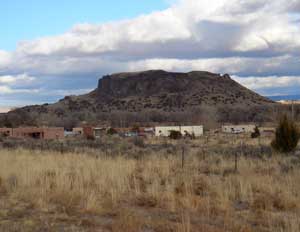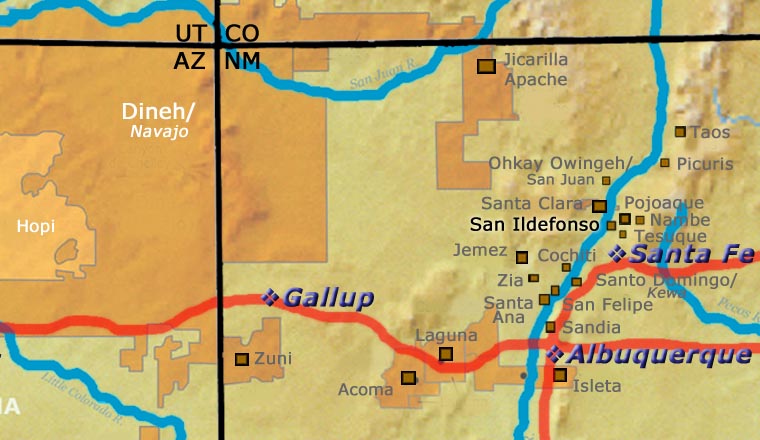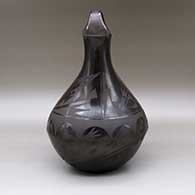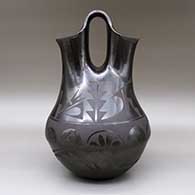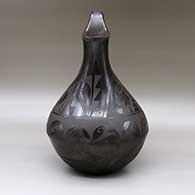
Carmelita Dunlap
San Ildefonso
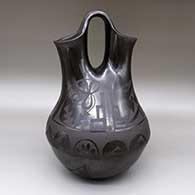
Carmelita Vigil was born into San Ildefonso Pueblo in 1925. The daughter of Juanita and Romando Vigil, she was also a niece of Maria Martinez and Desideria Montoya. Her mother died when she was eight years old. At that point, she began splitting her time between Maria's and Desideria's households, a few months with one, then a few months with the other. She watched both women making pottery and learned from both but she always referred to Desideria as "Grandma."
Like most Native American teenagers of the time, she was sent to a boarding school designed to remove her Native American heritage. It failed, but it was at that school that she met a San Carlos Apache student named Carlos Dunlap. After graduating, she and Carlos got married and moved to California to find work. A decade later they returned to San Ildefonso and Carmelita threw herself into making pottery. She established herself with red and cream polychromes, then moved to black-on-black pottery and finally to the sunrise brown that is now her family's specialty.
Carmelita was a regular participant in the Santa Fe Indian Market from 1978 to 1999, and at the Eight Northern Pueblos Arts & Crafts Show from 1995 to 1999. Carmelita was also a participant in the 1974 Seven Families in Pueblo Pottery show at the Maxwell Museum of Anthropology at the University of New Mexico in Albuquerque. Carmelita passed her knowledge on to her daughters, Jeannie Mountain Flower Dunlap, Linda (Turquoise Lake) Dunlap and Cynthia Star Flower Dunlap, and her son, Carlos Sunrise Dunlap (although he passed on in 1981 at the age of 23).
Some Awards Carmelita has Earned
- 1989: Second Place, Painted jar over 8 inches tall, Santa Fe Indian Market
- 1992: Second Place, Painted jar over 8 inches tall, Santa Fe Indian Market
- 1998: Honorable Mention, Painted jar over 8 inches tall, Santa Fe Indian Market
100 West San Francisco Street, Santa Fe, New Mexico 87501
(505) 986-1234 - www.andreafisherpottery.com - All Rights Reserved

San Ildefonso Pueblo
San Ildefonso Pueblo is located about twenty miles northwest of Santa Fe, New Mexico, mostly on the eastern bank of the Rio Grande. Although their ancestry has been traced to prehistoric pueblos in the Mesa Verde area, their most recent ancestral home is in the area of Bandelier National Monument, the prehistoric village of Tsankawi in particular. Tsankawi abuts the reservation on its northwest side.
A mission church was built in 1617 and named for San Ildefonso. Hence the name. Before that the village was called Powhoge, "where the water cuts through" (in Tewa). Today's pueblo was established as long ago as the 1300s. When the Spanish arrived in 1540, they estimated the village population at about 2,000.
That mission was destroyed during the Pueblo Revolt of 1680 and when Don Diego de Vargas returned to reclaim the San Ildefonso area in 1694, he found virtually all the Tewa people on top of nearby Black Mesa. After an extended siege the two sides negotiated a treaty and the people returned to their villages. However, the next 250 years were not good for them. The Spanish swine flu pandemic of 1918 reduced the pueblo's population to about 90. Their population has grown to more than 600 now but the only economic activity available on the pueblo involves creating art in one form or another. The only other work is off-pueblo. San Ildefonso's population is small compared to neighboring Santa Clara Pueblo, but the pueblo maintains its own religious traditions and ceremonial feast days.
San Ildefonso is most known for being the home of the most famous Pueblo Indian potter, Maria Martinez. Many other excellent potters from this pueblo have produced quality pottery, too, among them: Blue Corn, Tonita and Juan Roybal, Dora Tse Pe and Rose Gonzales. Of course the descendants of Maria Martinez are still important pillars of San Ildefonso's pottery tradition. Maria's influence reached far and wide, so far and wide that even Juan Quezada of the Mata Ortiz pottery renaissance in Chihuahua, Mexico, came to San Ildefonso to learn from her.
100 West San Francisco Street, Santa Fe, New Mexico 87501
(505) 986-1234 - www.andreafisherpottery.com - All Rights Reserved

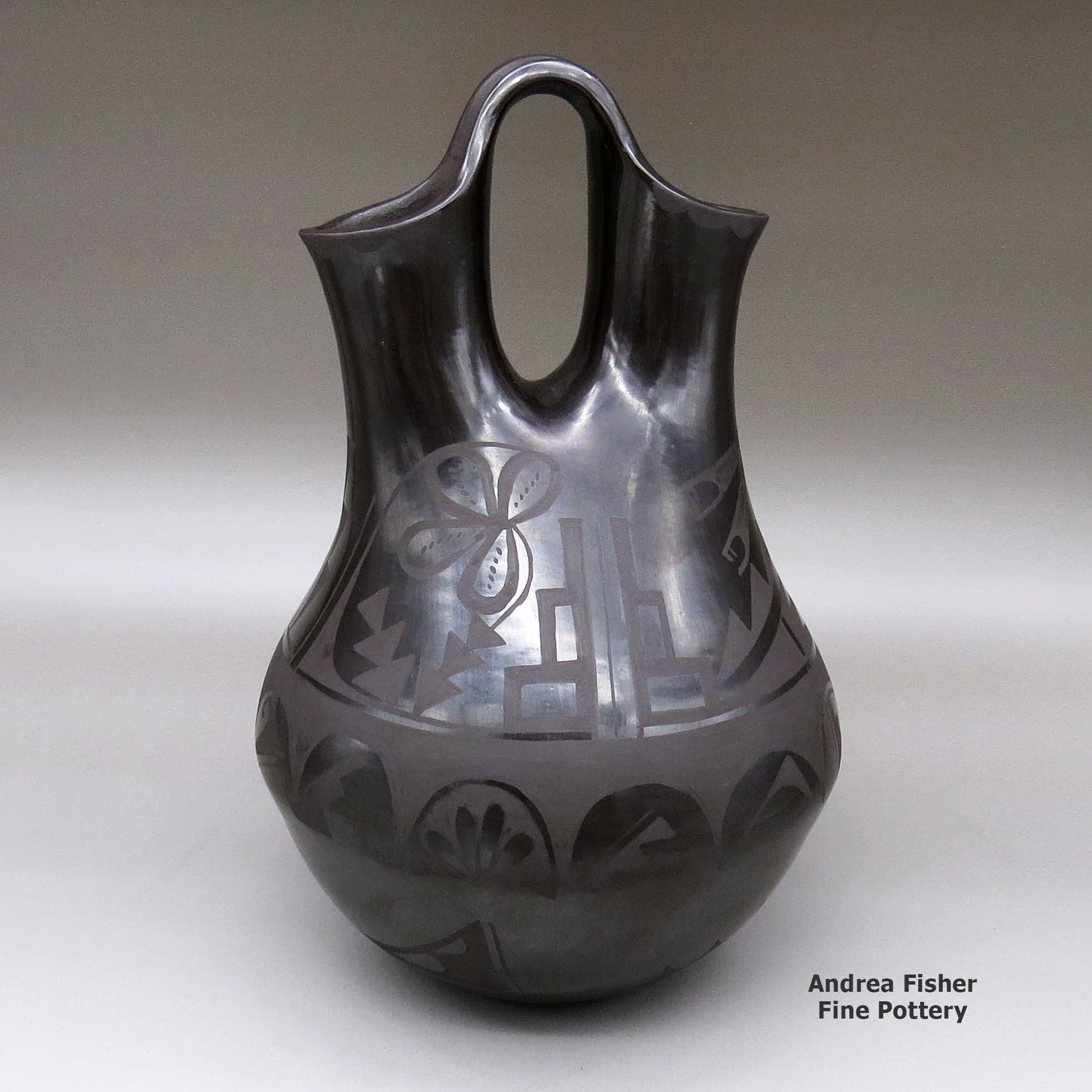
Carmelita Dunlap, San_Ildefonso, Largeblack-on-blackweddingvasewithaflower,kivastep,andgeometricdesign
San Ildefonso
$ 3400
cjsi3k066
Large black-on-black wedding vase with a flower, kiva step, and geometric design
10.25 in L by 10.25 in W by 16 in H
Condition: Very good, pencil marks, adhesive residue, and rubbing on bottom and scratches, rubbing, and normal wear on sides
Signature: Carmelita Dunlap San Ildefonso Pueblo
100 West San Francisco Street, Santa Fe, New Mexico 87501
(505) 986-1234 - www.andreafisherpottery.com - All Rights Reserved

The Story of
the Wedding Vase
as told by Teresita Naranjo of Santa Clara Pueblo
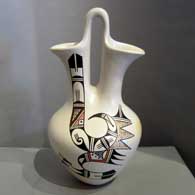
Helen Naha
Hopi
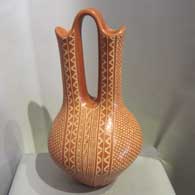
Wilma Baca Tosa
Jemez Pueblo
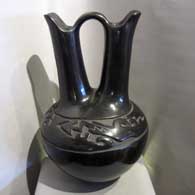
Margaret Tafoya
Santa Clara Pueblo
The Wedding Vase has been used for a long, long time in Indian Wedding Ceremonies.
After a period of courtship, when a boy and girl decide to get married, they cannot do so until certain customs have been observed. The boy must first call all his relatives together to tell them that he desires to be married to a certain girl. If the relatives agree, two or three of the oldest men are chosen to call on the parents of the girl. They pray according to Indian custom and the oldest man will tell the parents of the girl what their purpose is in visiting. The girl's parents never give a definite answer at this time, but just say that they will let the boy's family know their decision later.
About a week later, the girl calls a meeting of her relatives. The family then decides what answer should be given. If the answer is “no” that is the end of it. If the answer is “yes” then the oldest men in her family are delegated to go to the boy's home, and to give the answer, and to tell the boy on what day he can come to receive his bride-to-be. The boy must also notify all of his relatives on what day the girl will receive him, so that they will be able to have gifts for the girl.
Now the boy must find a Godmother and Godfather. The Godmother immediately starts making the wedding vase so that it will be finished by the time the girl is to be received. The Godmother also takes some of the stones which have been designated as holy and dips them into water, to make it holy water. It is with this holy water that the vase is filled on the day of the reception.
The reception day finally comes and the Godmother and Godfather lead the procession of the boy's relatives to the home of the girl. The groom is the last in line and must stand at the door of the bride's home until the gifts his relatives have brought have been opened and received by the bride.
The bride and groom now kneel in the middle of the room with the groom's relatives and the bride's parents praying all around them. The bride then gives her squash blossom necklace to the groom's oldest male relative, while the groom gives his necklace to the bride's oldest male relative. After each man has prayed, the groom's necklace is placed on the bride, and the bride's is likewise placed on the groom.
After the exchange of squash blossom necklaces and prayers, the Godmother places the wedding vase in front of the bride and groom. The bride drinks out of one side of the wedding vase and the groom drinks from the other. Then, the vase is passed to all in the room, with the women all drinking from the bride's side, and the men from the groom's.
After the ritual drinking of the holy water and the prayers, the bride's family feeds all the groom's relatives and a date is set for the church wedding. The wedding vase is now put aside until after the church wedding.
Once the church wedding ceremony has occurred, the wedding vase is filled with any drink the family may wish. Once again, all the family drinks in the traditional manner, with women drinking from one side, and men the other. Having served its ceremonial purpose, the wedding vase is given to the young newlyweds as a good luck piece.
